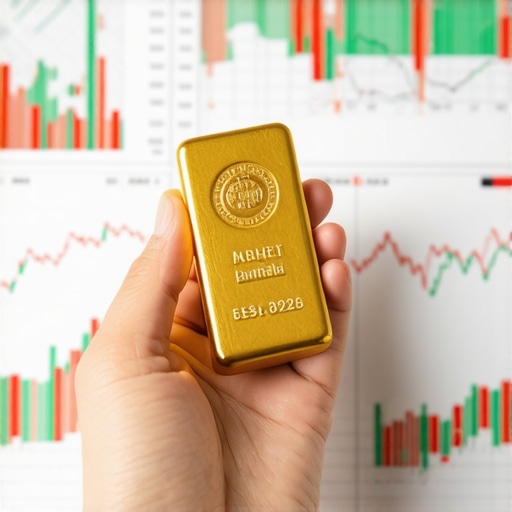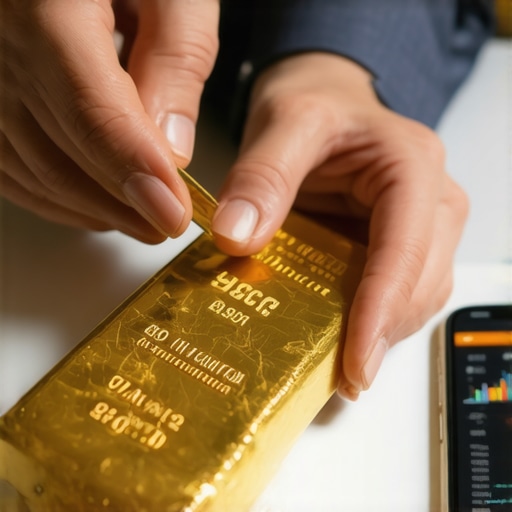Unlocking the Door to Gold Investing: Why Start with Gold ETFs?
For beginners venturing into the precious metals market, gold exchange-traded funds (ETFs) represent a compelling gateway. Unlike owning physical gold, gold ETFs offer liquidity, ease of access, and cost efficiency, allowing investors to gain exposure to gold’s value without the complexities of storage or authentication. This article explores how novices can confidently select their first gold ETF, leveraging expert insights to navigate this investment terrain effectively.
Decoding Gold ETFs: Beyond the Basics
Gold ETFs are investment funds traded on stock exchanges, designed to track the price of gold. They blend the stability of gold with the convenience of stock trading. However, not all gold ETFs are created equal. Factors such as the fund’s structure, expense ratios, liquidity, and underlying assets significantly impact performance and risk.
For instance, some ETFs hold physical gold bullion in secured vaults, while others invest in gold futures or mining stocks. Understanding these distinctions is crucial for aligning your investment with your financial goals and risk tolerance.
Creative Strategies: Selecting the Ideal Gold ETF for Your Portfolio
Choosing your first gold ETF demands a strategic approach. Consider funds with low expense ratios to minimize costs and high trading volumes to ensure liquidity. Additionally, review the fund’s track record and how closely it tracks gold prices, as tracking errors can erode returns.
For example, the SPDR Gold Shares (GLD) is one of the largest and most liquid gold ETFs, holding physical gold. Meanwhile, funds like the VanEck Vectors Gold Miners ETF (GDX) focus on mining stocks, offering leveraged exposure but with increased volatility.
What Are the Risks and Rewards of Investing in Gold ETFs Compared to Physical Gold?
Gold ETFs offer convenience and diversification benefits but also come with risks such as counterparty risk and reliance on the fund manager’s integrity. Physical gold, while tangible and free from counterparty risk, entails storage, insurance, and liquidity challenges.
Investors should weigh these factors carefully. Gold ETFs are ideal for those seeking ease of access and the ability to trade quickly, whereas physical gold suits investors prioritizing direct ownership and long-term preservation.
Expert Insight: Navigating Market Volatility with Gold ETFs
Gold has historically served as a hedge against inflation and market downturns. Strategic allocation to gold ETFs can stabilize portfolios during economic uncertainty. According to Investopedia, gold ETFs provide a practical way to diversify investments and protect wealth without the logistical burdens of physical gold.
Moreover, monitoring global gold demand trends and central bank purchases can inform optimal timing and selection of ETFs, enhancing potential returns.
Take Your First Step with Confidence
Embarking on your gold investment journey through ETFs can unlock new financial opportunities. To deepen your understanding and master the essentials, explore our quick guide to starting with gold ETFs. Share your experiences or questions in the comments below to join a community of savvy investors advancing their portfolios with gold.
Understanding Expense Ratios and Their Impact on Gold ETF Returns
Expense ratios are a critical, yet often underestimated, factor when selecting a gold ETF. These fees represent the annual cost of managing the fund and are deducted from the fund’s assets, directly impacting net returns. For example, an expense ratio difference of just 0.2% can compound significantly over time, especially for long-term investors. It’s essential to compare expense ratios across similar ETFs to ensure you’re not eroding your gains unnecessarily.
Beyond costs, investors should assess how these fees correlate with the services provided, such as the quality of gold storage, transparency in reporting, and liquidity support. Funds like the iShares Gold Trust (IAU) typically offer competitive expense ratios, making them attractive for cost-conscious investors.
Liquidity and Trading Volume: Why They Matter in Gold ETF Selection
Liquidity, reflected in trading volume, affects how easily you can enter or exit a position without significantly impacting the price. High liquidity enhances pricing efficiency and reduces bid-ask spreads, which can save investors money over multiple trades. The SPDR Gold Shares (GLD), with its high average daily volume, exemplifies a liquid gold ETF, favored by both retail and institutional investors.
Conversely, lower-volume ETFs may present challenges during volatile markets, potentially leading to wider spreads and less favorable trade executions. Evaluating liquidity alongside your investment horizon and strategy will help optimize your trading experience.
Exploring Physical vs. Synthetic Gold ETFs: What Should Investors Know?
While many gold ETFs hold physical bullion, some utilize synthetic structures involving derivatives such as gold futures contracts or swaps. Synthetic ETFs may offer cost advantages but introduce counterparty risk, where the fund’s performance depends on the creditworthiness of third parties.
For investors prioritizing safety and transparency, ETFs holding physical gold are generally preferable. However, synthetic ETFs can be suitable for sophisticated investors seeking specific exposures or cost efficiencies. Due diligence on the fund’s structure and counterparty risk mitigation strategies is vital before investing.
How Do Global Economic Indicators Influence Gold ETF Performance?
Gold prices and, consequently, gold ETF performances are intricately tied to macroeconomic factors such as inflation rates, currency strength, and geopolitical stability. Inflationary pressures often boost gold demand as investors seek to preserve purchasing power, while a strong U.S. dollar typically weighs on gold prices due to inverse correlation.
Geopolitical tensions and market volatility can drive flight-to-safety demand, benefiting gold ETFs. Staying attuned to these indicators enables investors to anticipate market shifts and adjust their gold ETF allocations accordingly.
For a comprehensive analysis of these dynamics, Investopedia’s guide on gold price drivers provides valuable expert insights grounded in current market data.
Integrating Gold ETFs into a Diversified Portfolio: Practical Considerations
Gold ETFs serve as a strategic diversification tool, often counterbalancing equity and bond market risks. Allocations typically range between 5-15% of an overall portfolio, depending on risk tolerance and investment objectives. This allocation helps mitigate downside during economic shocks without overly limiting growth potential.
Investors should consider rebalancing periodically to maintain target exposure, especially during periods of heightened volatility or gold price fluctuations. Combining gold ETFs with other asset classes such as stocks and bonds can enhance portfolio resilience and long-term wealth preservation.
For those interested in deeper strategies, reviewing smart gold investment strategies can provide actionable guidance on blending gold ETFs with physical gold and equities.
Call to Action: Share Your Gold ETF Experiences and Expand Your Knowledge
Your journey into gold ETFs can benefit greatly from community insights and expert advice. Have you navigated challenges related to ETF selection, liquidity, or market timing? Share your experiences or questions in the comments below to contribute to a vibrant discussion among knowledgeable investors.
Additionally, explore our complete guide to investing in gold ETFs for beginners to build a robust understanding and optimize your investment decisions.
Decoding the Complex Tax Landscape of Gold ETFs: Strategies for Maximizing After-Tax Returns
Investing in gold ETFs introduces not only market risks and opportunities but also intricate tax considerations that can significantly impact net returns. Unlike traditional equities, gold ETFs are often classified as collectibles by tax authorities, subjecting gains to unique tax rates and reporting requirements. For example, in the United States, gains from gold ETFs can be taxed at a maximum rate of 28% under the IRS’s collectibles rules, differing from the standard long-term capital gains rates applicable to stocks.
Moreover, the tax treatment varies depending on whether you hold physical gold ETFs or those backed by futures contracts. ETFs holding physical bullion are generally taxed as collectibles, while synthetic ETFs or those investing in gold mining stocks may fall under standard capital gains tax regimes. Understanding these nuances is essential for sophisticated investors aiming to optimize their tax liabilities.
Implementing tax-efficient strategies, such as holding gold ETFs in tax-advantaged accounts like IRAs or 401(k)s, can shield gains from immediate taxation and enhance compounding potential. Additionally, employing tax-loss harvesting techniques during market dips can offset gains and reduce tax burdens over time.
Regulatory and Compliance Considerations: Navigating the Evolving Gold ETF Landscape
The regulatory environment surrounding gold ETFs continues to evolve, influenced by global financial regulations, anti-money laundering (AML) policies, and market transparency mandates. Investors must stay informed about the compliance frameworks governing their chosen ETFs, as regulatory shifts can affect fund operations, liquidity, and risk profiles.
For instance, some gold ETFs have adjusted their structures to comply with the European Union’s Markets in Financial Instruments Directive II (MiFID II), enhancing transparency but potentially increasing operational costs. Similarly, U.S. Securities and Exchange Commission (SEC) oversight ensures adherence to disclosure norms but may impose constraints on fund leverage and derivatives use.
Staying abreast of these regulatory dynamics helps investors anticipate potential impacts on fund performance and operational stability, thereby informing more resilient investment choices.
How Can Advanced Investors Leverage Derivatives Within Gold ETFs to Enhance Portfolio Performance?
Certain gold ETFs incorporate derivatives such as futures, options, and swaps to achieve leveraged exposure or hedge against price fluctuations. These instruments can amplify returns but also introduce heightened complexity and risk, including counterparty default and liquidity challenges.
Sophisticated investors may use gold ETFs with embedded derivatives as tactical tools to capitalize on short-term market movements or to hedge other portfolio exposures. For example, leveraged gold ETFs aim to deliver multiples of daily gold price changes, catering to active traders rather than buy-and-hold investors.
However, the compounding effects of daily resets and volatility can lead to performance deviations over longer periods, necessitating careful monitoring and timing. Comprehensive knowledge of the ETF’s prospectus and risk disclosures is paramount before engaging with these products.
For an in-depth exploration of derivatives in commodity ETFs, the CFA Institute’s research digest offers expert guidance rooted in quantitative analysis and market theory.
Embracing Technology and Analytics: Tools for Optimizing Gold ETF Investment Decisions
Modern investors have access to a growing arsenal of analytical tools and technology platforms that provide real-time data on gold ETF performance, liquidity metrics, and macroeconomic indicators. Leveraging advanced charting software, algorithmic screening, and sentiment analysis can uncover nuanced entry and exit points, risk exposures, and correlations with other asset classes.
Machine learning models and AI-driven platforms can synthesize vast datasets to forecast potential gold price movements and optimize portfolio allocations dynamically. Integrating these technologies fosters a proactive investment approach, enabling sophisticated investors to stay ahead in rapidly shifting markets.
By combining expert knowledge with cutting-edge analytics, investors can enhance decision-making precision, manage risk more effectively, and ultimately achieve superior risk-adjusted returns.
Call to Action: Deepen Your Expertise and Share Your Advanced Gold ETF Strategies
Are you navigating the complexities of gold ETF taxation, regulatory changes, or derivative use in your portfolio? Join the conversation by sharing your insights and questions in the comments below. Engaging with a community of experts sharpens your understanding and opens doors to innovative strategies.
For a comprehensive deep dive into advanced gold ETF investing techniques, explore our expert guide on gold ETF taxation, regulation, and derivatives. Equip yourself with the knowledge to elevate your portfolio to the next level.
Decoding the Intricacies of Gold ETF Taxation: Strategic Approaches for Professionals
For seasoned investors, understanding the tax implications of gold ETFs is paramount to maximizing after-tax returns. Unlike traditional securities, gold ETFs often attract unique tax treatments, especially when classified as collectibles, leading to potential tax rates as high as 28% on long-term gains in jurisdictions like the United States. Moreover, the differentiation between physical-backed ETFs and synthetic or mining-stock-based ETFs further complicates the tax landscape.
To navigate these complexities, advanced investors should consider utilizing tax-advantaged accounts such as IRAs or 401(k)s, which can defer or exempt tax liabilities on gold ETF gains. Additionally, incorporating tax-loss harvesting during market corrections can strategically offset realized gains, optimizing portfolio efficiency.
Harnessing Derivative Instruments Within Gold ETFs: Balancing Leverage and Risk
Some sophisticated gold ETFs employ derivatives including futures, options, and swaps to achieve leveraged exposure or hedge underlying risks. While these instruments can amplify returns during bullish cycles, they also introduce layers of counterparty and liquidity risk that demand rigorous due diligence.
Leveraged gold ETFs, for instance, are designed primarily for short-term tactical trading rather than long-term holding due to daily reset compounding effects that can result in performance divergence from the underlying gold price.
Investors considering these products must meticulously analyze the ETF’s prospectus, risk disclosures, and understand the mechanics of embedded derivatives to align with their investment horizon and risk appetite.
Integrating Cutting-Edge Analytics and AI: Revolutionizing Gold ETF Portfolio Management
Advancements in financial technology offer investors unparalleled insights into gold ETF dynamics. Utilizing AI-driven platforms and machine learning algorithms enables the synthesis of macroeconomic indicators, sentiment analysis, and real-time liquidity data to forecast price movements with higher precision.
Algorithmic screening tools can identify optimal entry and exit points based on nuanced patterns, while portfolio optimization software dynamically adjusts exposure to gold ETFs in response to volatility and correlation shifts with other asset classes.
This integration of technology empowers investors to adopt a proactive stance, transforming traditional gold ETF investing into a data-driven, adaptive strategy that maximizes risk-adjusted returns.
How Can Institutional Investors Effectively Mitigate Counterparty Risks in Synthetic Gold ETFs?
Institutional investors often grapple with counterparty risk inherent in synthetic gold ETFs, which utilize derivatives to replicate gold price exposure. To mitigate this, they conduct thorough counterparty credit assessments, favor ETFs with collateralized swaps, and prefer funds governed by stringent regulatory oversight.
Furthermore, diversification across physical and synthetic ETFs can balance risk profiles. Employing stress testing scenarios and monitoring counterparty exposure limits are standard practices within institutional risk management frameworks.
For an authoritative exploration of these risk mitigation strategies, the CFA Institute’s research digest provides comprehensive analysis grounded in empirical data and theoretical rigor.
Call to Action: Elevate Your Gold ETF Expertise with Advanced Insights and Community Engagement
Embarking on advanced gold ETF investing requires not only knowledge but also continuous engagement with evolving market dynamics and peer insights. Share your sophisticated strategies, tax optimization techniques, or derivative experiences in the comments below to foster a rich dialogue among expert investors.
To further hone your skills, explore our expert guide on gold ETF taxation, regulation, and derivatives and leverage cutting-edge analytics for a competitive edge.
Frequently Asked Questions (FAQ)
What exactly is a gold ETF and how does it differ from owning physical gold?
A gold exchange-traded fund (ETF) is a financial instrument traded on stock exchanges that aims to track the price of gold. Unlike physical gold ownership, which involves holding tangible bullion, gold ETFs offer exposure through shares representing gold holdings or derivatives. ETFs provide liquidity, ease of trading, and eliminate storage or insurance concerns, but they introduce counterparty and management risks absent in physical gold.
How do expense ratios impact the returns of gold ETFs over time?
Expense ratios represent the annual fees charged by the fund to manage assets. Even small differences—such as 0.1% to 0.3%—can compound substantially over long investment horizons, eroding net returns. Investors should compare expense ratios carefully and balance costs against services like transparency, liquidity, and fund structure to optimize performance.
What risks should I consider when investing in synthetic versus physical gold ETFs?
Synthetic gold ETFs use derivatives such as futures or swaps to replicate gold price movements, exposing investors to counterparty credit risk and potential liquidity constraints. Physical gold ETFs hold actual bullion in vaults, reducing counterparty risk but potentially incurring higher storage costs. Understanding these distinctions helps align investments with risk tolerance and objectives.
How do macroeconomic factors influence gold ETF performance?
Gold prices respond strongly to inflation trends, currency strength (notably the US dollar), geopolitical tensions, and market volatility. Inflationary environments typically increase gold demand as a hedge, while a stronger dollar can suppress gold prices due to inverse correlation. Monitoring these indicators can guide strategic adjustments to gold ETF allocations.
What tax considerations should I be aware of when investing in gold ETFs?
Gold ETFs often fall under unique tax regimes, especially in jurisdictions like the US where they may be classified as collectibles and taxed at higher rates (up to 28%) than standard equities. Tax treatment also varies by ETF type—physical-backed versus synthetic or mining-stock ETFs. Utilizing tax-advantaged accounts and tax-loss harvesting can reduce tax liabilities and improve after-tax returns.
How can derivatives within gold ETFs affect portfolio risk and return?
Derivatives such as futures, options, and swaps can amplify exposure to gold price movements but also introduce complexity, counterparty risk, and potential tracking errors. Leveraged gold ETFs using daily resets are generally suited for short-term trading rather than long-term holdings due to performance deviations. Investors must carefully assess derivative use in ETFs relative to their risk appetite.
What role do liquidity and trading volume play in selecting a gold ETF?
High liquidity and trading volume enable efficient trade execution with tighter bid-ask spreads, reducing transaction costs and price impact. ETFs like SPDR Gold Shares (GLD) exemplify highly liquid options. Low liquidity ETFs may experience wider spreads and higher volatility, especially in stressed markets, which can negatively affect returns and exit strategies.
How should gold ETFs be integrated into a diversified investment portfolio?
Gold ETFs serve as a strategic diversifier, typically representing 5-15% of a balanced portfolio depending on risk tolerance. They provide a hedge against inflation and equity market downturns, enhancing portfolio resilience. Periodic rebalancing ensures target allocations are maintained amid market fluctuations, optimizing risk-adjusted returns.
Are there advanced tools or technologies that can aid in gold ETF investing?
Yes, AI-driven analytics, machine learning models, and algorithmic screening tools can analyze real-time market data, macroeconomic indicators, and sentiment to forecast gold price trends and identify optimal trade timing. These technologies enable dynamic portfolio adjustments, improving decision-making precision and risk management for sophisticated investors.
How can institutional investors mitigate counterparty risk in synthetic gold ETFs?
Institutions mitigate counterparty risk by conducting rigorous credit assessments, favoring ETFs with collateralized derivatives, ensuring regulatory compliance, and diversifying exposure between physical and synthetic ETFs. Employing stress testing and monitoring exposure limits are standard risk management practices to maintain portfolio integrity.
Trusted External Sources
- World Gold Council (WGC): As the authoritative industry body for gold investment, WGC provides comprehensive data, market analysis, and research on gold demand, supply, and investment vehicles including ETFs, helping investors understand market fundamentals.
- CFA Institute Research Foundation: Offers in-depth scholarly research and practical insights on commodity ETFs, derivatives use, risk management, and portfolio diversification strategies, contributing rigorous empirical and theoretical guidance.
- U.S. Securities and Exchange Commission (SEC): Provides regulatory disclosures, filings, and compliance information on gold ETFs, enabling investors to verify fund structure, risk factors, and fee transparency critical for informed decision-making.
- Investopedia: Offers expert-curated educational content clarifying complex topics such as gold ETF taxation, expense ratios, and macroeconomic influences, serving as a reliable resource for both beginners and advanced investors.
- Morningstar: Specializes in detailed fund analytics, performance metrics, expense ratio comparisons, and liquidity data, equipping investors with quantitative tools to evaluate and select optimal gold ETFs.
Conclusion: Synthesizing Expert Insights on Gold ETFs for Informed Investing
Gold ETFs represent a sophisticated yet accessible avenue for investors seeking exposure to gold’s enduring value and portfolio diversification benefits. Navigating this landscape requires careful consideration of fund structures, expense ratios, liquidity, tax implications, and macroeconomic dynamics. While physical gold offers tangible security, ETFs provide unmatched trading flexibility and cost efficiency.
Advanced investors can harness derivatives and technology-driven analytics to refine portfolio strategies, balancing leverage with risk management. Understanding regulatory environments and adopting tax-efficient approaches further enhance after-tax returns and investment resilience.
Whether a novice or seasoned professional, integrating gold ETFs thoughtfully within a diversified portfolio can safeguard wealth and capitalize on gold’s unique market role. Engage with the community by sharing your experiences, exploring expert guides, and applying these insights to elevate your investment journey.
Start your gold ETF investment with confidence today—share your questions, insights, and strategies to join a network of knowledgeable investors advancing their financial goals.










